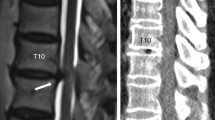Abstract
Degenerative changes in the intervertebral disks have become common in civilized world. Disk herniation is one of the major causes of degenerative disorders and radiology gives a fundamental contribution in the diagnosis of this condition. In this paper the Authors describe the role of various radiological techniques, discussing limits and indications of conventional radiology, MR, CT, discography and myelography.
Similar content being viewed by others
Bibliografia
Pearce RH, Grimmer BJ, Adams ME (1987) Degeneration and the chemical composition of the human lumbar intervertebral disc. J Orthop Res 5:198–205
Deyo RA, Tsui-Wu YJ (1987) Descriptive epidemiology of low-back pain and its related medical care in the United States. Spine 12:264–268
Cypress BK (1983) Characteristics of physician visits for back symptoms: a national perspective. Am J Public Health 73:389–395
Boden SD, Wiesel SW (1996) Lumbar spine imaging: role in clinical decision making. J Am Acad Orthop Surg 4:238–248
Brant-Zawadzki MN, Jensen MC, Obuchowski N et al (1995) Interobservers and intraobserver variability in interpretation of lumbar disc abnormalities. A comparison of two nomenclatures. Spine 20:1257–1263
Milette PC (1997) The proper terminology for reporting lumbar intervertebral disk disorders. AJNR Am J Neuroradiol 18:1859–1866
Fardon DF (2001) Nomenclature and classification of lumbar disk pathology. Recommendations of the Combined task Forces of the North American Spine Society, American Society of Spine Radiology, and American Society of Neuroradiology. Spine 26:93–113
Zeidman SM, Ducker TB (1992) Cervical disk diseases. Neurosurg Quart 2:116–163
Arce CA, Dohrmann GJ (1985) Herniated thoracic disks. Neurol Clin 3:383–392
Weber H (1983) Lumbar disc herniation. A controlled, prospective study with ten years of observation. Spine 8:131–140
Kerry S, Hilton S, Patel S et al (2000) Routine referral for radiography of patients presenting with low back pain: is patients’ outcome influenced by GPs’ referral for plain radiography? Health Technol Assess 4:1–119
Drapé JL, Bach F, Guerini H et al (2004) Examens d’imagerie dans la pathologie lombaire dégénérative. EMC — Rhumatologie-Orthopédie 1:365–394
Annertz M, Wingstrand H, Strömqvist B, Holtås S (1996) MR imaging as the primary modality for neuroradiologic evaluation of the lumbar spine. Effects on cost and number of examinations. Acta Radiol 37:373–380
Freund M, Sartor K (2006) Degenerative spine disorders in the context of clinical findings. Eur J Radiol 58:15–26
Stoller DW, Hu SS, Kaiser JA (1997) The spine. In: Stoller DW (Ed.) Magnetic resonance imaging in orthopaedics and sports medicine. Lippincott-Raven, Philadelphia New York, pp 1059–1162
Yousem DM, Atlas SW, Hackney DB (1992) Cervical spine disk herniation: comparison of CT and 3DFT gradient echo MR scans. J Comput Assist Tomogr 16:345–351
Boden SD, Davis DO, Dina TS et al (1992) Contrast-enhanced MR imaging performed after successful lumbar disk surgery: prospective study. Radiology 182:59–64
Mullin WJ, Heithoff KB, Gilbert TJ Jr, Renfrew DL (2000) Magnetic resonance evaluation of recurrent disc herniation: is gadolinium necessary? Spine 25:1493–1499
Stoller DW, Genant HK, Chafetz NI, Lang P (1987) Applications of computed tomography in the musculoskeletal system. Curr Orthop 1:219–226
Tsuchiya K, Katase S, Aoki C et al (2003) Application of multidetector row helical scanning to postmyelographic CT. Eur Radiol 13:1438–1443
Guyer RD, Ohnmeiss DD (1995) Lumbar discography. Position statement from the North American Spine Society Diagnostic and Therapeutic Committee. Spine 20:2048–2059
Guyer RD, Ohnmeiss DD; NASS (2003) Lumbar discography. Spine J 3[3 Suppl]:11–27
Author information
Authors and Affiliations
About this article
Cite this article
Garbagna, G.P., Failoni, S., Rampini, C. et al. La diagnostica stumentale radiologica delle ernie discali. Arch Ortop Reumatol 119, 7–9 (2008). https://doi.org/10.1007/s10261-008-0241-7
Published:
Issue Date:
DOI: https://doi.org/10.1007/s10261-008-0241-7




